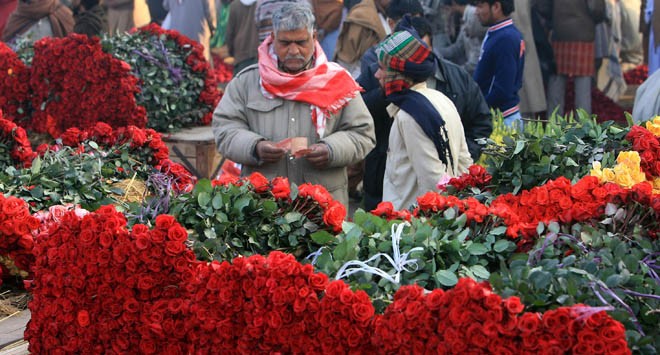

It’s a treat for the citizens of Lahore to move around in spring time only to be greeted by the lovely flowers planted in green belts, along the walls, in public parks and in the green areas on roadsides.
The most decorated part of the city is indeed the Mall Road where one can find handcrafted flowerbeds (in green belts) and blossoms grown in different -- vertical as well as horizontal -- arrangements.
At the same time, the people are being lured in to public parks in hordes by the myriad flower shows and contests arranged by different organisations.
One can see traditional flowers as well as exotic and hybrid kinds, recently introduced in this part of the world. The foreign plants appear to be much larger in number and for a moment one gets the impression that the indigenous plants such as rose, marigold and narcissus have taken a back seat.
Besides, many of the newly introduced flowers are labeled F1 varieties -- a term many visitors are not familiar with.
Mudaser Ijaz, Director, Parks and Horticulture Authority (PHA), explains the concept. He says that the F1 varieties of plants are those where the ratio of the flowers to the green part of the plant is high. Therefore, he says, it is a better option to grow F1 flowers which are prominent and give a colourful look. F1 plants are smaller in size; there are less leaves and stems but they carry a significantly large number of flowers.
On the other hand, the local varieties of rose plants etc have heavier green part (or foliage) and lesser flowers which make them unsuitable for the purpose.
The American rose, however, is a different variety and preferred when roses have to be grown for decorative purposes because it has more flowers and less foliage.
According to Mudaser, petunias and pansies are grown on a much larger scale as they come in different colours and catch the attention of the spectators. Their seeds are hybrid and imported from Korea and Japan. These countries have developed seeds which produce excellent results. The size of the flower is good and the colours are enchanting. The seeds obtained from the crop do not give the same result as achieved by using the imported seed, he adds.
Apart from the plantations by the government sector, there is a lot of contribution of the private sector which has invested heavily in floriculture. Agricultural scientists and farmers’ organisations believe the decrease in farm holdings and increasing public interest in use of flowers have made people enter this business. The people have developed the habit of offering bouquets, garlands etc on different occasions -- a proof of which is that a large number of shops have opened next to marriage halls, hospitals etc.
Ibrar Ahmed, a grower, says that rose, tuberose, gladiolus, marigold, narcissus, statice, petunia, pansy, freesia and lily are some of the most popular flowers grown in fertile areas in and around the city.
A drive across the Saggian Bridge over the Ravi river and towards Jaranwala, Lahore, leads one to the famous Flower Chowk where the flowers grown in Saggian, Sheikhupura, Sharaqpur, Pattoki and other fertile areas in the vicinity are traded at the wholesale level.
The otherwise congested road, occupied by all types of traffic, comes under total control of flower growers, merchants, buyers, commission agents soon after the morning prayers. Pick-ups, vans and trucks filled to the brim with flowers can be seen parked on both sides of the road and all one can see all around is colour.
Muhammad Islam, salesman at Chishti Flower Center, says rose and marigold are the most heavily traded commodities at the wholesale market. Rose is available at Rs30-40 per kg at present but its price is raised to as much as Rs1,000 per kg when it is in high demand.
The peak times, according to Islam, are around Eid-ul-Fitr, Aashura and the wedding seasons prior to Ramzan and Muharram.
Though rose is not quite visible on the city roads and public parks, Islam says, this is the season when its production is at peak.
This is also the time when herbal companies, hakeems and other people prepare derivatives of rose such as gulqand and rose water.
Islam says marigold is also very popular as it is used extensively for wedding decorations, at shrines and religious gatherings and in bouquets. It is used specifically to decorate venues for mehndi functions because of its mustard yellow colour.
Mudaser Ijaz, Director, PHA, cites another reason for rose and marigold not being there in the greenbelts and parks: different plants are planted in different seasons. As rose and marigold are available almost all year round, they lose their novelty value.
Ijaz also says the preparations for saplings begin two months ahead of the plantation of seasonal flowers and it is made sure that nothing is missed. The saplings are grown in small pots and shifted to ground only when they are strong enough to survive.
Javaid Shaida, Deputy Director, PHA, says different educational institutions such as Aitchison College, Kinnaird College, Punjab University and Government College University have also focused on floriculture and grown flowers on lands available to them.
Similarly, different government departments and private sector organisations such as Millat Tractors, Packages and Honda grow flowers and regularly participate in flower competitions. All this has served to promote a culture where flowers are loved.